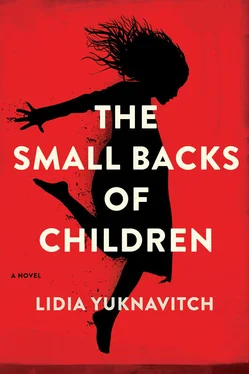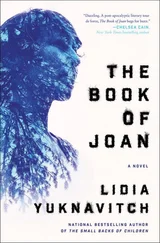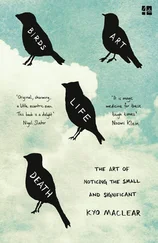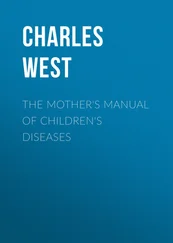Artillery fire. Or a stray missile. Or a bomb. Avisual. Reverse origin.
The poet and the girl run from the room through the blast hole, fire around their forms.
How a story can change in the violence of an instant. How content is a glimpse of something.
And in the end a train carries them. And a plane lifts them into the sky. On the plane the poet tells the girl the story of how she came to find her, and why. The girl listens, not catching all of what this woman is saying to her, since her English is still forming. But individual words and lines and images go into her. And the quivering in the poet’s hands when she lifts the little airplane drink up to her face again and again. And the tiny lines near her eyes that have written themselves this day. And the marks on the poet’s body that the girl knows hide violence like a skin song beneath her clothes. And the girl carries something with her as small as a seed.
The first year I lived with the American artists is a collage.
This is a house.
These are the rooms.
This one, your room.
A room of your own.
We are giving it to you.
Because we can.
This is the table of the artists, where we eat and speak and act out relations.
This is the school, the American Interdisciplinary Art School.
Isn’t it something?
This is the in-home entertainment system with Sensurround sound and these are the Mac computers and this is a cell phone with a computer and this is software to make films in the sanctity of one’s own home.
Can you believe it?
This is what’s bad: The Nixon administration. The Reagan administration. The Bush administrations. War. Poverty. Injustice. Christians. Oil. Racists. Global warming. Homophobia. Corporations. The plight of third world nations.
This is money.
This is how we shop online.
This is Organic.
This is a haircut, makeup, jewelry, scented soaps. This is how to be a girl in this country. Pink.
I am upstairs in the painting room they created for me, in a house surrounded by firs, ferns, alders. I am the only one home. I lick the skin of my arm. Salt. Then I hear the UPS truck grumbling its way toward the house. I know it will stop here; I can see when it arrives from this wide upstairs room where I paint. It comes once a month. For years. Once a month a delivery of canvas, paper, paint, brushes, linseed oil, turpentine, art books. For me.
The deliveries come from a man who has become the exiled American painter in my mind’s eye. I have learned about him through their stories of him, how he rose to fame as an abstract painter, how he used women as if they were paint, how he shot his wife the writer. And I have read about him through my own research on the Internet, through all the media this country so lavishly spills all over everything.
It seems important to them that he is a kind of villain in their stories. This seems American.
There is something I have never told them. For seven years now, deep inside the delivery packaging, this man — the American painter — hides little notes, and I find them as I use the materials. Sable brushes are preferable to any other — don’t waste your time with the small ones. Detail work is for Dutch dead men. Use the light from the window in the room they’ve created for you — never artificial light. Never. Take ten steps back from your work every hour or you will lose sight of it. Don’t think. Don’t know. Just paint. If you must paint with your hands, use these — latex gloves. Oil paint can kill you, for fuck’s sake. The notes are rolled around tubes of paint or brushes, slid between pages in books, buried inside rolls of paper or written in pencil on canvas. These secret hieroglyphics from the man who shot his wife.
All I ever wanted was canvas. Even when the environment was dire.
The UPS truck is pulling up the gravel drive, through the alder trees. I close my eyes and breathe.
The second year I lived here is a mural with the images of three women on it in different states. The first woman is the writer. I saw her one morning emerging from the shower, dripping with water. A woman who suffered great loss and did not die. Baptismal.
The second image of a woman is the poet’s body before I untied her in the room of her torture, her arms outspread, her naked body carrying the trace of violence as if her wounds had been painted. Velázquez.
The third image of a woman is a girl — for there is no girl we are not always already making into a woman from the moment she is born — making a city in the dirt next to the boot of a man. It could be rage or love in his feet. The girl could be me or any other girl.
The third year I lived here is a double portrait, like a deformed reflection.
The left side is a girl with a wolf’s paw in place of a hand. She stands naked in a pool of her own blood, her head lifted upward as she laughs a whole sky filled with snow geese and song. The right side is the writer, her journal resting in her hands, the words filling the space so that her face, her hair, her mouth, her eyes are made of language. A mother and a girl who are separate but joined.
The fourth year is a painting at the bottom of the stairs, in the living room opposite the wall that wears the famous photo of me as a child. How strange to look at one of my paintings next to this photograph of. . is it of me? How?
My painting is different from the photo. In the photo, they say over and over again that the girl is a “victim of violence.” But in my painting, a young woman comes out of fire with a vengeance in her stare. Her stone blue eyes finding you.
The fifth and sixth years are animal: wolves turning into girls, girls turning into fire.
The seventh year is now. The painting I am making now.
To make a small pool of blood to use with paint, place a bowl between your legs, not an artificially scented wad of cotton. You must move outside what you have been told.
I am painting the spread legs of a grown woman, the mouth of her opening up to the viewer, her breasts a terrain just before her face in the distant background.
With my hands.
On a six-feet-by-six-feet canvas.
In this room in a house they have given to me.
Inside her cleft will be hands.
Her hair will be woven with wolves.
The UPS truck is nearly at the house, and I am the only one here just now, so I will need to go to the door and sign for the delivery. I clean my hands with wipes, leaving the act of painting and moving into the act of looking.
I think of the canvas like a body. It is alive. It is a body and I am a body and my inner rhythms tell me how to move with this other body.
I have read about the history of painting.
There are things in my head that no one has taught me, that I have not read or seen or heard anywhere else. They come out from my hands.
For the fleshy inside of her thighs, then, I will use blood and indigo.
I turn and leave the room, making my way down the stairs of this house. The UPS truck’s little horn blows three times. My feet on each stair step look cartoonlike to me — little Nike symbols making their marks.
Are there more brands of shoes in America than there are children in the world?
Seven years I have lived with this small group of American artists. I know all their stories. The playwright’s story is the drama of a brother and sister; a family plot. The poet’s story is a relentless body. The filmmaker’s story is flex and light and speed: action and male. The writer’s journal crosses the terrain of loss and love like a great white tundra.
The painter shot his wife and the photographer shot me, to make art.
I think art is a place where all our stories collect.
Читать дальше












